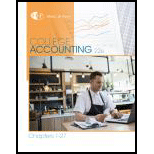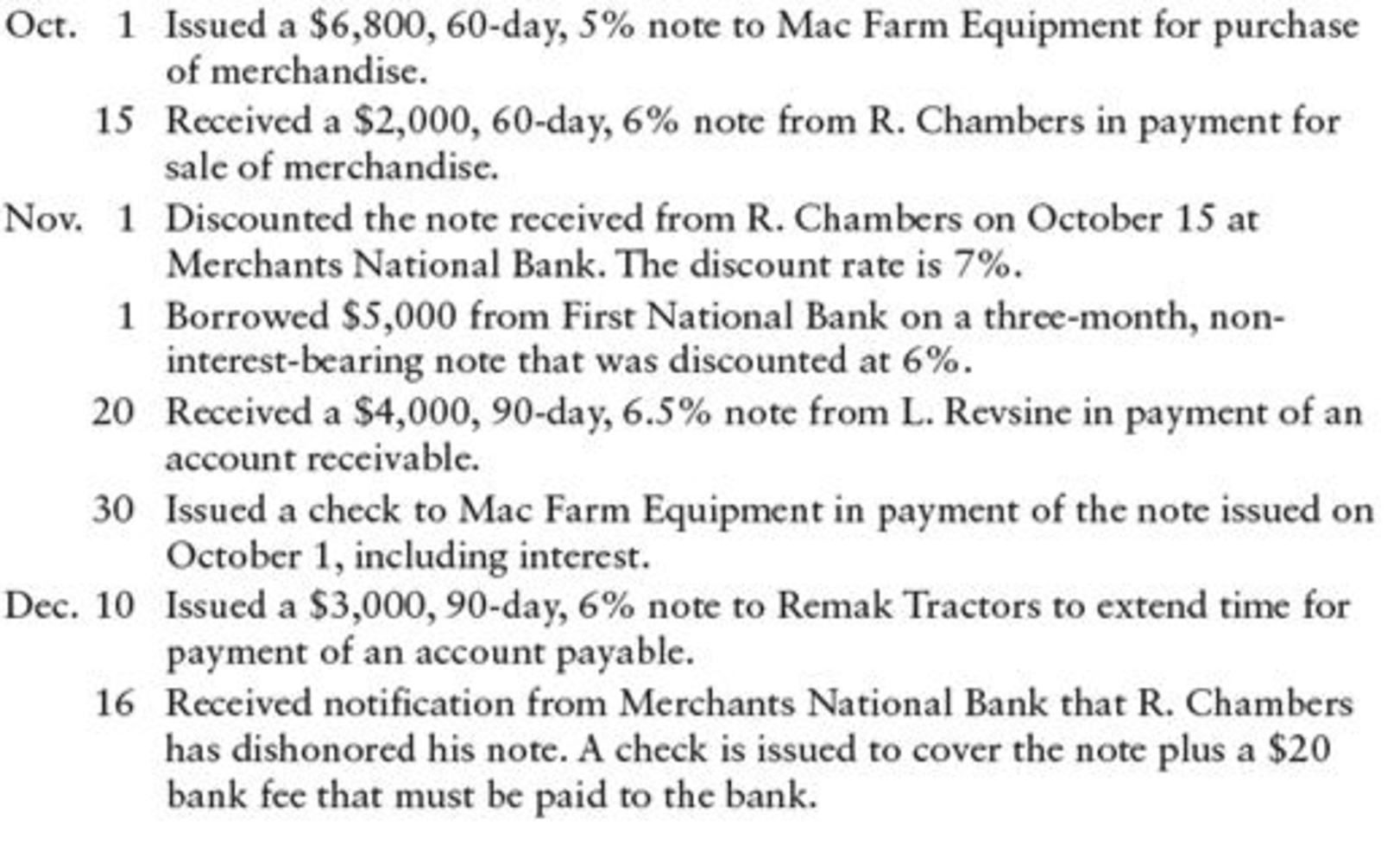
Concept explainers
Eddie Edwards and Phil Bell own and operate The Second Hand Equipment Shop. The following transactions involving notes and interest were completed during the last three months or 20--:

REQUIRED
- 1. Prepare general
journal entries for the transactions. - 2. Prepare necessary
adjusting entries for the notes outstanding on December 31.
1.
Prepare journal entry to record the following transactions.
Explanation of Solution
Note receivable:
Note receivable refers to a written promise for the amounts to be received within a stipulated period of time. This written promise is issued by a debtor or, borrower to the lender or creditor. Notes receivable is an asset of a business.
Prepare journal entry to record the following transactions.
| Date | Account titles and Explanation | Debit | Credit |
| October 1 | Purchases | $6,800 | |
| Notes payable | $6,800 | ||
| (To record note issued for inventory purchases) | |||
| October 15 | Notes receivable | $2,000 | |
| Sales | $2,000 | ||
| (To record note received for merchandise for sale) | |||
| November 1 | Cash (1) | $2,003.11 | |
| Notes receivable | $2,000 | ||
| Interest revenue (2) | $3.11 | ||
| (To record discount on notes receivable) | |||
| November 1 | Cash (4) | $4,925 | |
| Discount on notes payable (3) | $75 | ||
| Notes payable | $5,000 | ||
| (To record issued note for bank loan) | |||
| November 20 | Notes receivable | $4,000 | |
| Accounts receivable - L.R | $4,000 | ||
| (To record received note to settle account) | |||
| November 30 | Notes payable | $6,800 | |
| Interest expense (5) | $56.67 | ||
| Cash | $6,856.67 | ||
| (To record paid note with interest at maturity) | |||
| December 10 | Accounts payable - RT | $3,000 | |
| Notes payable | $3,000 | ||
| (To record issued note to settle account) | |||
| December 16 | Accounts receivable - R.C (6) | $2,040 | |
| Cash | $2,040 | ||
| (To record paid bank for dishonoured note) |
Table (1)
Working notes:
(1) Calculate cash proceeds.
(2) Calculate interest expense.
(3) Calculate discount on notes payable.
(4) Calculate cash proceeds.
(5) Calculate interest expenses.
(6) Calculate accounts receivable.
2.
Prepare adjusting entries for the notes outstanding on 31st December.
Explanation of Solution
Adjusting entries: Adjusting entries are those entries which are recorded at the end of the year, to update the income statement accounts (revenue and expenses) and balance sheet accounts (assets, liabilities, and stockholders’ equity) to maintain the records according to accrual basis principle.
Prepare adjusting entries for the notes outstanding on 31st December.
| Date | Account titles and Explanation | Debit | Credit |
| December 31 | Interest expense (7) | $50 | |
| Discount on notes payable | $50 | ||
| (To record adjusting entry for interest expense) | |||
| December 31 | Interest expense (8) | $10.50 | |
| Accrued interest payable | $10.50 | ||
| (Record adjusting entry for interest expense) | |||
| December 31 | Accrued interest receivable | $29.61 | |
| Interest revenue (9) | $29.61 | ||
| (To record adjusting entry for interest revenue) |
Table (2)
Working notes:
(7) Calculate interest expense.
(8) Calculate interest expense.
(9) Calculate interest revenue.
Want to see more full solutions like this?
Chapter 17 Solutions
College Accounting, Chapters 1-27 (New in Accounting from Heintz and Parry)
- I don't need ai answer general accounting questionarrow_forwardCan you help me with accounting questionsarrow_forwardCariveh Co sells automotive supplies from 25 different locations in one country. Each branch has up to 30 staff working there, although most of the accounting systems are designed and implemented from the company's head office. All accounting systems, apart from petty cash, are computerised, with the internal audit department frequently advising and implementing controls within those systems. Cariveh has an internal audit department of six staff, all of whom have been employed at Cariveh for a minimum of five years and some for as long as 15 years. In the past, the chief internal auditor appoints staff within the internal audit department, although the chief executive officer (CEO) is responsible for appointing the chief internal auditor. The chief internal auditor reports directly to the finance director. The finance director also assists the chief internal auditor in deciding on the scope of work of the internal audit department. You are an audit manager in the internal audit…arrow_forward
- Cariveh Co sells automotive supplies from 25 different locations in one country. Each branch has up to 30 staff working there, although most of the accounting systems are designed and implemented from the company's head office. All accounting systems, apart from petty cash, are computerised, with the internal audit department frequently advising and implementing controls within those systems. Cariveh has an internal audit department of six staff, all of whom have been employed at Cariveh for a minimum of five years and some for as long as 15 years. In the past, the chief internal auditor appoints staff within the internal audit department, although the chief executive officer (CEO) is responsible for appointing the chief internal auditor. The chief internal auditor reports directly to the finance director. The finance director also assists the chief internal auditor in deciding on the scope of work of the internal audit department. You are an audit manager in the internal audit…arrow_forwardProvide solution of this all Question please Financial Accountingarrow_forwardDon't Use AIarrow_forward
- Century 21 Accounting Multicolumn JournalAccountingISBN:9781337679503Author:GilbertsonPublisher:Cengage
 Financial AccountingAccountingISBN:9781337272124Author:Carl Warren, James M. Reeve, Jonathan DuchacPublisher:Cengage Learning
Financial AccountingAccountingISBN:9781337272124Author:Carl Warren, James M. Reeve, Jonathan DuchacPublisher:Cengage Learning


